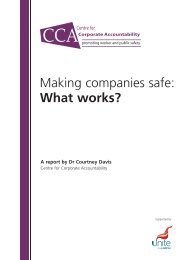Manual Handling Manual Handling Operations Regulations 1992 ...
Manual Handling Manual Handling Operations Regulations 1992 ...
Manual Handling Manual Handling Operations Regulations 1992 ...
You also want an ePaper? Increase the reach of your titles
YUMPU automatically turns print PDFs into web optimized ePapers that Google loves.
Health and Safety<br />
Executive<br />
Guidance<br />
Does the task involve reaching upwards?<br />
90 Reaching upwards places additional stresses on the arms and back. Control<br />
of the load becomes more difficult and, because the arms are extended, they are<br />
more likely to be injured.<br />
Does the task involve considerable lifting or lowering distances?<br />
91 The distance through which a load is lifted or lowered can also be important:<br />
large distances are considerably more demanding physically than small ones. Also,<br />
lifting or lowering over a large distance is likely to need a change of grip during the<br />
operation, further increasing the risk of injury. Lifts beginning at floor level or above<br />
head height should be avoided where possible.<br />
Does the task involve considerable carrying distances?<br />
92 In general, if a load can safely be lifted and lowered, it can also be carried<br />
without endangering the back. However, if a load is carried for an excessive<br />
distance, physical stresses are prolonged, leading to fatigue and increased risk<br />
of injury. As a rough guide, if a load is carried further than about 10 m then the<br />
physical demands of carrying the load will tend to predominate over those of lifting<br />
and lowering and individual capability will be reduced.<br />
Does the task involve considerable pushing or pulling of the load?<br />
93 Most pushing and pulling workplace activities are introduced as a way of<br />
reducing manual handling, for example eliminating carrying by loading goods onto<br />
a trolley. However, lifting, lowering and carrying, pushing or pulling a load can harm<br />
the handler. The majority of injuries resulting from pushing and pulling activities<br />
affect the back, neck and shoulders. Entrapment injuries are also common.<br />
Approximately two-thirds of push/pull accidents involve objects that are not<br />
supported on wheels, for example, furniture or bales of wool.<br />
94 Points to consider when reducing the risks from pushing and pulling include:<br />
(a)<br />
(b)<br />
(c)<br />
(d)<br />
(e)<br />
(f)<br />
the length of the route. Is this as short as possible?<br />
the number of journeys. Would it be safer to make repeated journeys rather<br />
than a few demanding ones?<br />
how demanding the work is;<br />
whether the route is clear of obstacles, including doorways;<br />
whether the floor surface is well maintained;<br />
whether the task involves negotiating kerbs, steps or slopes. Full use should<br />
be made of ramps etc.<br />
4(1)(b)(i) and (ii)<br />
95 The initial forces used to overcome the object’s inertia when starting or<br />
changing direction are usually higher than the sustained forces used to keep the<br />
object moving and should therefore be kept to a minimum. Frequent starting,<br />
stopping and manoeuvring should be avoided, as should jerky movements and<br />
high sustained forces. The risk of injury is also increased if pushing or pulling is<br />
carried out with the hands much below waist height or above shoulder height.<br />
Being able to adopt a comfortable, stable posture is important and twisted or bent<br />
postures should be avoided.<br />
<strong>Manual</strong> handling Page 27 of 90
















